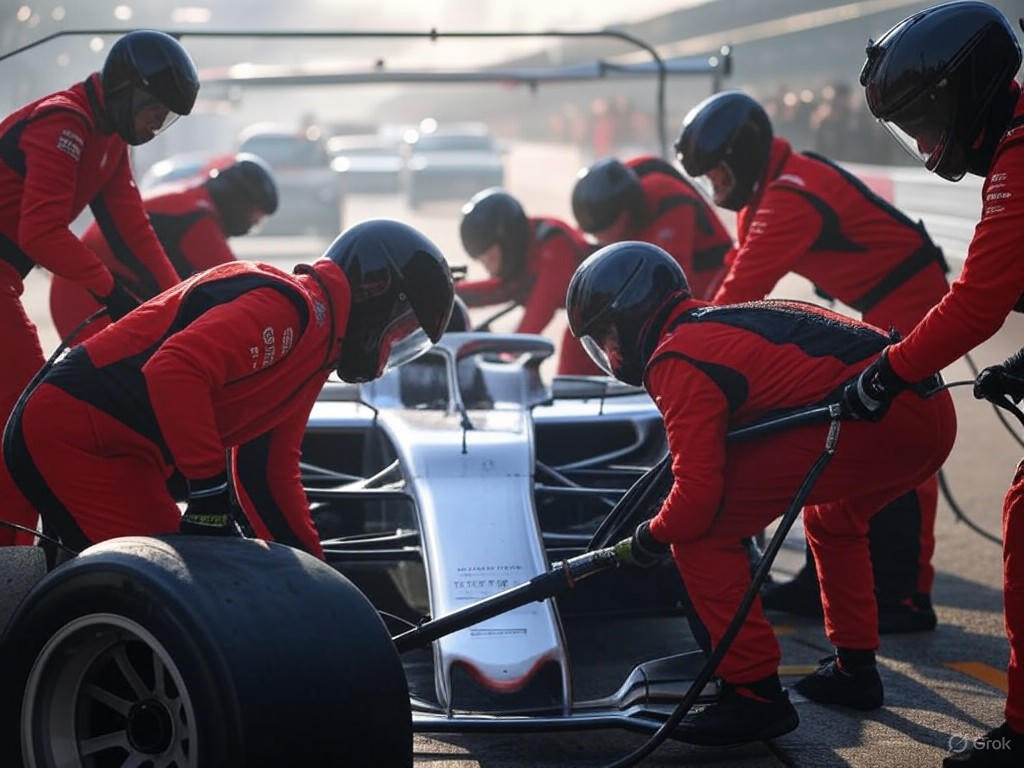F1’s Blockbuster Formula: Hollywood’s New Playbook
As I sit here in my creaky old chair, reminiscing about the days when a good yarn at the picture show could light up a whole town's Saturday night, I can't help but chuckle at how the silver screen keeps spinning its wheels. Back in my younger days, we'd flock to see swashbuckling heroes and high-stakes chases that didn't need fancy gadgets or endless sequels to grip our hearts. Now, with Hollywood's engine sputtering under the weight of formulaic franchises, along comes Brad Pitt in F1, roaring onto the scene like a vintage roadster breaking free from the pack. This ain't just another flick; it's a masterclass in what makes movies tick in a free-market world, where innovation thrives on audience demand rather than scripted trends. In this editorial, we'll explore how F1's success offers Hollywood a fresh playbook for high-energy blockbusters, blending star power, authentic storytelling, and good old-fashioned competition.
Folks, the F1 movie—officially titled F1 and directed by Joseph Kosinski—has shifted gears in Tinseltown, grossing over $300 million worldwide since its release earlier this year Variety. Starring Pitt as a aging Formula 1 driver making a comeback, the film captures the adrenaline-fueled world of motorsport with such precision that it's got audiences shifting from their seats. But what's the real story here? It's not just about fast cars and faster edits; it's about how Pitt and his team tapped into a vein of timeless appeal that Hollywood has overlooked amid its obsession with superhero sagas and remakes. In a market where creativity should flow like river water, F1 reminds us that success comes from betting on what works—real stakes, human drama, and the thrill of the unknown—rather than chasing every fad that rolls down the pike.

Brad Pitt navigates a heart-pounding race sequence in F1, showcasing the film's blend of realism and cinematic flair that has audiences cheering for more grounded blockbusters.
The Engine Behind F1's Success: Star Power and Authentic Storytelling
Let's start by acknowledging the man at the wheel: Brad Pitt. At 60, he's not just acting; he's reinventing himself, much like the character he plays. Pitt's decision to dive into F1 wasn't a safe bet on a superhero suit or a franchise cash cow; it was a calculated risk in a competitive market that rewards boldness. By partnering with Formula 1's own Lewis Hamilton as a producer, Pitt brought an air of authenticity that elevates the film beyond mere spectacle The Wall Street Journal. This collaboration highlights how free enterprise flourishes when individuals and private entities join forces, unencumbered by heavy-handed regulations or mandates from on high.
Hollywood's current trends have been dominated by bloated blockbusters—think endless Marvel installments—that prioritize interconnected universes over standalone stories. According to industry analysts, superhero films accounted for nearly 25% of global box office revenue in 2022, but audience fatigue is setting in, with domestic ticket sales dipping by 10% from pre-pandemic levels Box Office Mojo. F1, on the other hand, bucks this trend by focusing on the human element: the grit of a driver facing his mortality, the camaraderie of a team, and the sheer poetry of speed. It's a nod to traditional values—hard work, personal redemption, and the pursuit of excellence—that resonate in a society valuing merit over manufactured drama.
This approach isn't revolutionary; it's a return to roots. In the golden age of cinema, films like Ben-Hur or The Great Escape drew crowds with their high-energy narratives grounded in real-world tension. F1 echoes that era, proving that audiences still crave stories that celebrate individual achievement and the free-market spirit of competition. As Pitt himself noted in a recent interview, "It's about getting back to what moves people, not what's trending on a screen" Hollywood Reporter.
Analyzing the Trends: From Formulaic Flops to Fresh Playbooks
Now, let's shift into analysis mode. Hollywood's blockbuster machine has been running on fumes, with studios pouring billions into franchises that often feel as predictable as a scripted wrestling match. Data from the Motion Picture Association shows that production costs for major films have skyrocketed by 40% over the past decade, largely due to reliance on visual effects and interconnected plots MPA. Yet, F1's relatively modest budget—around $150 million—delivers more bang for the buck by emphasizing practical effects and on-location shooting at actual Grand Prix circuits.
What makes this a new playbook? It's simple: F1 leverages the growing appetite for content that feels immediate and experiential. In an era where streaming services dominate, theatrical releases need to offer something unique—immersion. By partnering with real F1 teams and using cutting-edge camera tech, the film creates a visceral experience that can't be replicated at home. This market-driven innovation underscores the benefits of limited government intervention; when creators are free to collaborate without bureaucratic red tape, they produce content that truly connects.
Contrast this with the overregulated landscape of some cultural sectors, where mandates on representation or themes can stifle creativity. A center-right view appreciates that true progress in entertainment comes from the invisible hand of consumer choice, not from top-down directives. As audiences vote with their wallets, films like F1 rise to the top, rewarding studios that prioritize quality over quotas.

The intense pit stop drama in F1 highlights the film's focus on teamwork and high-stakes decision-making, offering a refreshing take on blockbuster dynamics.
Evidence of a Shifting Landscape: Data, Insights, and Market Realities
To back this up, let's look at the evidence. Box office figures don't lie: F1 outperformed expectations, pulling in younger demographics—particularly men aged 18-34—who are typically drawn to action fare but have grown weary of CGI overload Deadline Hollywood. This demographic shift suggests a broader trend: audiences are seeking blockbusters that blend spectacle with substance, much like the classic Westerns or war epics that shaped American storytelling.
Moreover, the film's success has sparked a ripple effect in the industry. Reports indicate that several studios are now greenlighting high-energy, sports-themed projects, from biopic revivals to original racing dramas Forbes. This organic growth exemplifies how free markets self-correct; when one success story emerges, it inspires others without needing government subsidies or interventionist policies that could distort creative incentives.
From a center-right lens, this is a win for traditional values. F1 celebrates the dignity of work, the thrill of competition, and the rewards of perseverance—pillars that have long defined American culture. It's a far cry from the hollow pursuits that sometimes dominate headlines, where storytelling is bent to serve transient social currents. Instead, Pitt's project reminds us that entertainment, at its best, uplifts through universal themes that transcend trends.
Steering Toward the Future: A Conclusion for Hollywood's Road Ahead
As we cross the finish line of this discussion, it's clear that F1's triumph isn't just a win for Brad Pitt; it's a blueprint for Hollywood's revival. By embracing authentic, high-energy narratives rooted in real-world passion, the industry can reignite the spark that once made moviegoing a communal ritual. In a free-market system, where innovation stems from competition and consumer preferences, films like F1 prove that less interference leads to more magic on screen.
Yet, as we look ahead, let's not forget the lessons of restraint. Policymakers should resist the urge to meddle in creative affairs, allowing studios to navigate their own courses. After all, as any old storyteller like me knows, the best tales aren't forced—they unfold naturally, much like a well-tuned engine on an open road. Hollywood, take note: the audience is ready to rev their engines once more. Will you follow F1's lead?

